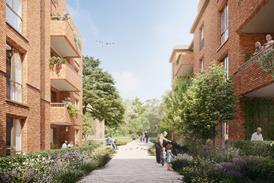Tom Venner’s first public statement since joining Canary Wharf Group (CWG) as development director last July offers one clue about his main task. The job in question being to draw up a new masterplan covering the 130-acre estate.

“Canary Wharf is an extraordinary place,” says Venner, who spent five years at HS2 and, more immediately, two years at the Euston Partnership, the public-private conglomerate marshalling plans for the station and surrounding rail yards. The clue being: “We are already a thriving metropolitan centre, and the UK’s most sustainable, mixed-use community.”
Recasting the masterplan for Canary Wharf should be a relative breeze for a man who has toiled on HS2 and its gigantic Euston terminus under what is called the ‘single guiding mind’ of the Euston Partnership. A mind attached to bodies as diverse as Network Rail, the London Borough of Camden, Lendlease and Skanska.
The single mind overseeing the new masterplan at Canary Wharf will be Venner’s, guided by CWG’s 50:50 owners, Brookfield and the state of Qatar, and supervised by chief executive Shobi Khan, who joined in 2019 from US SP-500 REIT General Growth Properties.
“The opportunities here for development are unparalleled,” says Venner, who spent 10 years at Land Securities, working on London developments and Ebbsfleet. “Canary Wharf is growing and changing day by day.” Indeed. Plans have been submitted for a £500m, 23-floor life sciences block.
The greening of the somewhat arid urban realm was announced last April in an imaginative partnership with the Eden Project. Around 900 of the 1,400 flats built for sale have been bought and 97% of the 1,100 build-to-rent (BTR) flats have been let at circa £50/sq ft. What comes next remains a gleam in Venner’s eye.
Numbers man and shaper

Canary Wharf’s famed maker was Sir George Iacobescu, an engineer who retired last year. Khan is more of a numbers man. His role is more that of shaper. The slim, bespectacled, 57-year-old was happy enough to colour in the details of what lay in the public domain during a stroll along the dockside boardwalks in December.
No more flats will be built for sale. Another 1,500 BTR flats are in the pipeline. The ‘Eden’ greening should be complete by the end of the year. A new footbridge linking to the concrete canyon of Marsh Wall is in the works. Mid-week travel numbers are back to pre-pandemic levels, he says.
The bad news for CWG is the epochal change in office use triggered by the work-from-home movement – news embodied in 13 directly owned office towers, containing 7.2m sq ft of space, standing amid another 10m sq ft owned by others. The 13 towers are valued at £5.86bn and generate rents that account for 75% of group income.
The current loan-to-value (LTV) ratio on the entire £8.7bn estate is 47.8%. The Wharf has lost law firm Clifford Chance to the City and HSBC is wavering about staying. That said, office rental income of £118m a year is lease-secured for a decade. Last year saw 450,000 sq ft let or placed under offer. But that’s not the issue.
CWG’s stated aim is to keep the LTV below 50%. In late December, Moody’s downgraded one of CWG’s £400m bonds into near-junk territory, citing the impact of a 10% to 15% fall in office values from the current June 2022 valuation. A 10% cut in the December 2022 valuation would reduce gross assets by close to £600m. Hard to see how the successful raising of £900m of external capital in a ‘green’ bond issue last year could be repeated. But given the owners include one of the richest states on the planet, it is also hard to see a development pipeline of 2m sq ft being seriously crimped for cash.
Weekend footfall is up 50% on Covid-hit 2021. The 300 shops, 80 bars and restaurants and growing leisure activities are a big draw. The malls were certainly thriving in early December. But still, what about all that office space? What’s the plan?
Peter Bill is a journalist and the author of Planet Property and Broken Homes






























No comments yet